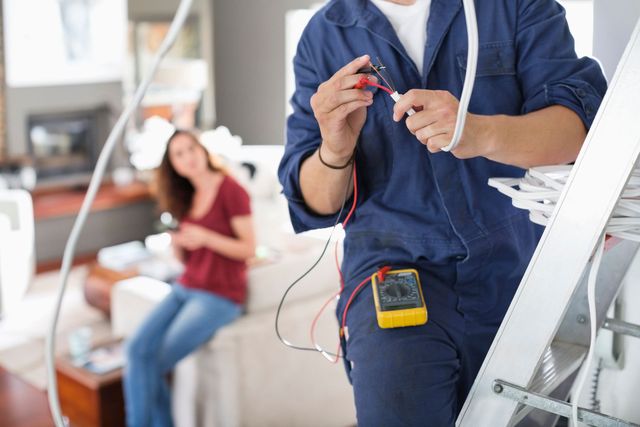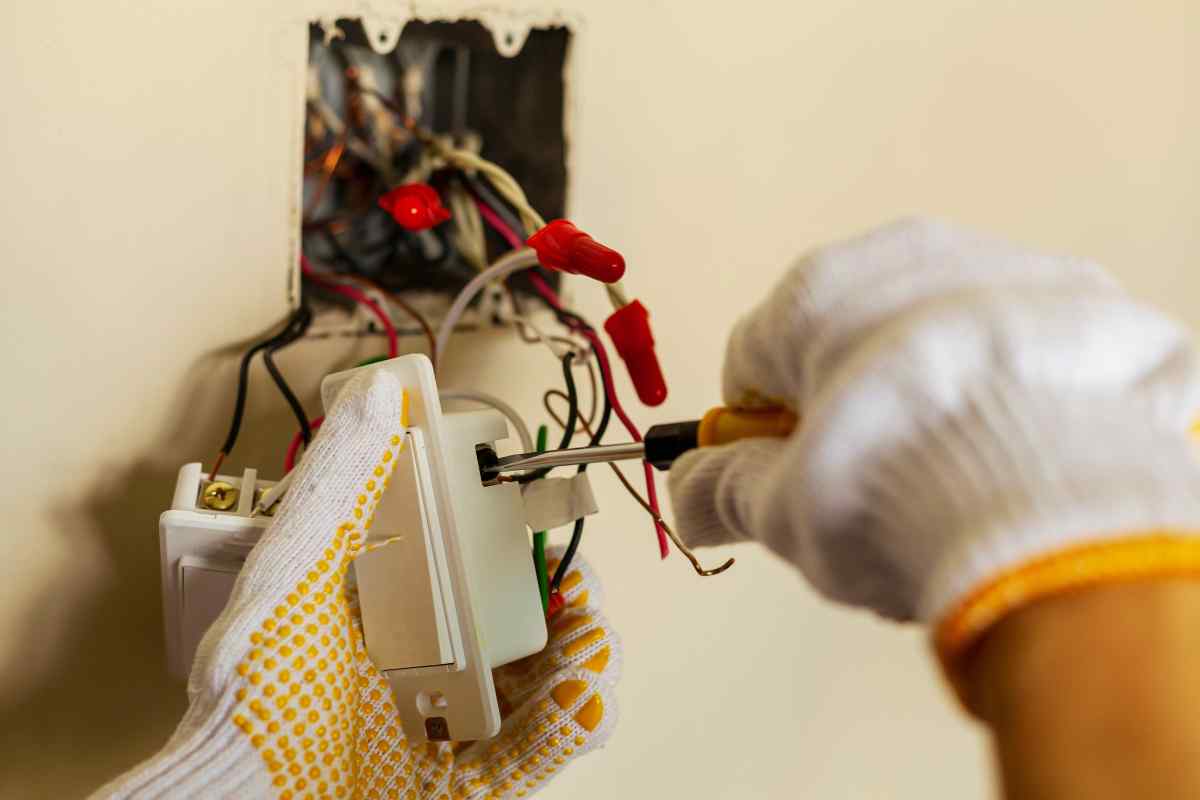Common Electrical Issues Every House Owner Must Find out about
Homeowners usually experience different electric problems that can influence security and functionality. Issues like flickering lights and stumbled breaker are more usual than lots of recognize. These scenarios can indicate deeper electric issues that warrant focus. Recognizing the threats and signs connected with out-of-date wiring and dead electrical outlets is crucial. What actions can be required to protect against these problems? Checking out these common electric issues might disclose important understandings for keeping a safe home atmosphere.

Flickering Lights: Reasons and Solutions
Why do some property owners experience flickering lights? Flickering lights can be an usual annoyance, frequently showing underlying electrical concerns. One key cause is loosened or faulty links within lighting fixtures or electrical wiring, which can cause intermittent power supply. In addition, making use of high-wattage devices on the exact same circuit may trigger voltage variations, causing flickering or dimming. Another potential concern is an overloaded circuit, where way too many tools draw power all at once, straining the electric system. Abject or obsolete circuitry can add to inconsistent electric flow. In many cases, flickering lights might signify a problem with the home's electrical panel or solution line. Property owners need to attend to flickering lights immediately to prevent prospective threats. Solutions might include tightening up links, rearranging appliance lots, or consulting an accredited electrical expert for a comprehensive assessment. Determining the origin reason can aid guarantee a risk-free and steady electrical system in the home.
Tripped Circuit Breakers: What You Required to Know
Have home owners ever questioned what causes their breaker to trip all of a sudden? This common issue typically occurs from an overload of electrical circuits, where way too many gadgets attract power concurrently. In such cases, the breaker acts as a safety and security system, interrupting the circulation of electrical power to stop getting too hot and possible hazards. One more constant cause is a short circuit, which occurs when an online cable calls a neutral wire, developing a surge of electrical power that trips the breaker. Ground mistakes can likewise lead to stumbled breakers; these occur when a live cord touches the ground or a grounded surface, posturing major safety and security risks. House owners should consistently analyze their use of high-wattage home appliances to prevent overloading circuits. In addition, comprehending the function of breaker can assist them respond properly throughout a journey, guaranteeing their home remains properly maintained and safe.
Out-of-date Wiring: Risks and indications
Out-of-date wiring can position significant risks to home owners, often going unnoticed until troubles arise. Homes developed before the 1980s might still have aluminum electrical wiring or knob-and-tube systems, which are no more thought about safe. Indicators of outdated wiring include flickering lights, often tripped circuit breakers, or melting scents near electrical outlets. These indications may recommend that the electrical system is overloaded or deteriorating.Additionally, house owners could see blister marks around electrical outlets or buttons, which can suggest getting too hot. The danger of electrical fires significantly increases with outdated wiring, as these systems were not made to take care of modern-day electric tons. Home owners are motivated to have their wiring evaluated frequently, specifically when refurbishing or adding brand-new home appliances. By recognizing these indications early, they can stay clear of unsafe circumstances and keep a much safer living environment. Upgrading to existing electric requirements is an aggressive action in preserving home safety and security and performance.
Often Blown Fuses: Repairing Tips
Regular blown merges can show underlying electrical issues that may stem from outdated electrical wiring or overloaded circuits. Homeowners experiencing this issue ought to initially recognize the home appliances attached to the influenced circuit. It is suggested to avoid using several high-wattage gadgets at the same time, as this can bring about circuit overload. If the trouble persists, checking the fuse box for indications of wear or damage is important; a damaged fuse box may need replacement.Additionally, inspecting for loose links within the circuit can aid stop future events. Home owners ought to likewise verify that the integrates being used are of the right amperage, as making use of an inaccurate fuse can exacerbate the issue. If these troubleshooting tips do not solve the concern, consulting a licensed electrical link contractor is recommended to examine the electrical system further. Resolving these issues without delay can aid mitigate threats and assure the safety and security of the home's electrical infrastructure.
Dead Outlets: Common Reasons and Repairs
When a home owner runs into a dead electrical outlet, it can commonly provide stress and complication. Numerous common causes may lead to this issue. One constant offender is a tripped circuit breaker, which can be conveniently reset. If any kind of breakers are in the off setting, house owners should examine their electrical panel to check. An additional possibility is a faulty outlet itself, which might need replacement. Furthermore, loose wiring links within the outlet can interrupt power flow, making assessment essential.Sometimes, the problem may originate from an overloaded circuit, particularly when several devices are linked. In such situations, rearranging the electrical load can solve the problem. Property owners should likewise take into consideration the age of their circuitry; older systems may require updates to satisfy modern electrical needs. If these steps do not remedy the situation, seeking advice from a qualified electrician is suggested to guarantee security and appropriate diagnosis.
Electric Shocks: When to Be Worried
Exactly how can homeowners identify whether an electric shock warrants concern? Property owners ought to initially analyze the seriousness and context of the shock. A light static shock, commonly felt when touching steel objects, is usual and usually harmless. If the shock happens while communicating with a plugged-in appliance or outlet, it might indicate a more major issue.The location and frequency of the shocks are crucial. Repetitive shocks from the very same source, specifically in wet areas like kitchen areas or washrooms, could signal damaged wiring or inadequate grounding. House owners need to likewise consider the sensation of the shock; a jolt that creates discomfort or muscle contractions is more alarming than a plain tingle.If there's any type of uncertainty, it is advisable to seek advice from a qualified electrical expert. Neglecting potential electrical risks can bring about significant security threats, consisting of fire or severe injury.
Overloaded Circuits: Avoidance and Precaution
Overloaded circuits present significant threats in domestic setups, usually causing electric fires or devices damage (Sydney Level 2 Electrician). Homeowners have to acknowledge the indicators of an overloaded circuit, such as often tripped breakers or lowering lights. Executing precautionary safety methods can help alleviate these threats and assure a safer living atmosphere
Recognizing Overloaded Circuits
What indicators suggest that a circuit may be overloaded? Home owners ought to be cautious for numerous crucial indicators. Often stumbled circuit breakers or blown integrates suggest extreme lots on the circuit. Dimming or flickering lights, particularly when other home appliances remain in usage, can indicate an insufficient power supply. Furthermore, outlets or buttons that really feel cozy to the touch might show overheating, a prospective fire hazard. Uncommon buzzing audios from outlets likewise necessitate attention, as they can signify electric concerns. Finally, if appliances run inefficiently or stop working to begin, it may suggest an overloaded circuit. Identifying these see this here indications early can aid prevent serious electrical problems and advertise a safer home atmosphere.
Preventive Security Practices
To keep a safe and reliable electric system, homeowners should carry out preventative safety techniques that deal with possible circuit overloads. One efficient action is to avoid linking too lots of tools to a solitary outlet, as this can exceed the circuit's capacity. Making use of power strips with integrated breaker can assist distribute power safely. Homeowners should additionally regularly evaluate cords and devices for damages and change any type of faulty devices quickly. It is essential to guarantee that breaker are operating appropriately and to be knowledgeable about the complete power level being used in each circuit. In addition, consulting an accredited electrician for regular examinations can recognize possible problems prior to they escalate, guaranteeing a more secure living environment and lengthening the life-span of electrical systems.
Frequently Asked Concerns
Exactly how Frequently Should I Have My Electrical System Inspected?
Regular assessments of electrical systems are suggested every 3 to 5 years. Property owners need to consider extra frequent checks if they experience concerns, embark on remodellings, or live in older properties to guarantee safety and security and compliance.
Can I Deal With Electric Problems Myself or Work With a Professional?

What Are the Indicators of an Electrical Fire Danger?
Signs of an electric fire threat include frequently stumbled circuit breakers, flickering lights, shedding odors, that site tarnished electrical outlets, or cozy, buzzing wires. Home owners ought to remain vigilant and seek expert aid if any of these signs are present.
Just how Do I Know if My Home Requirements an Electric Upgrade?
To establish if a home requires an electrical upgrade, indicators consist of constant breaker journeys, out-of-date circuitry, insufficient electrical outlets, flickering lights, and the visibility of older electric panels, suggesting prospective safety and security hazards and inefficiency.
Are There Certain Safety Tips for DIY Electrical Job?
When thinking about do it yourself electric job, one ought to always turn off power, use protected tools, verify circuit functionality, adhere to neighborhood codes, and consult experts for intricate jobs to guarantee safety and avoid mishaps. One more potential issue is an overloaded circuit, where as well numerous gadgets attract power all at once, stressing the electric system. The risk of electric fires markedly raises with out-of-date wiring, as these systems were not designed to handle contemporary electrical loads. Frequent blown integrates can indicate underlying electrical concerns that might stem from obsolete wiring or overloaded circuits. To preserve a reliable and secure electric system, property owners must carry out precautionary safety and security techniques that address possible circuit overloads. Level 2 Electrician Sydney. Indications of an electric fire risk consist of often tripped circuit breakers, flickering lights, melting odors, stained outlets, or warm, buzzing wires